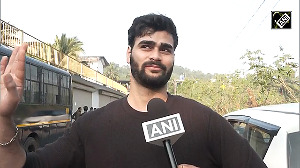If you are a busy executive, generally on the move but needs to constantly refer to your office documents and reply to e-mails, then you positively need a notebook (or a laptop).
Your desktop PC is more convenient with a larger keyboard, wider screen and has a more powerful processor. But you cannot carry it with you.
The good news is that laptop prices have fallen to even below Rs 30,000. However, souped-up laptops could even cost Rs 200,000. So, what should you look out for when buying a laptop?
1. Brands
It's advisable to go for a branded laptop (anyway, there is hardly an assembly market in India). Brands available in India include HP-Compaq, Dell, Lenovo, LG, Sony, ACI, Acer, Zenith, Asus, Toshiba and HCL.
2. Budget
Decide on a budget and scout for laptops within that range. Do remember that you can get high-end laptops (with high configurations) but at lower prices simply because the brand does not command a premium price. It does make sense to explore these laptops if the after-sales service is good.
3. Processor
That decided, you will come across names like Intel Celeron M Processor (basic), Intel Centrino Mobile Technology with Core Solo processor (mid-range) and Duo Mobile Technology with Core Duo (mid-range) and Core 2 Duo processors (high-end).
AMD (the other major chip player) offers Turion 64 (mid-range) and Sempron processors (basic). Apple die-hards can opt for the high-end PowerPC G4. However, regardless of what kind of processor you decide on, you should get at least 1.6GHz of processing speed (this is generally not specified in advertisements).
4. Memory and Video card
You can never have enough memory (especially with memory-hogging operating systems like Vista round the corner). However, for basic laptops, the bare minimum should be 512MB. High-end users should consider 1GB and above.
Basic laptops come with an integrated graphics card that shares memory with the system chipset (mostly an Intel and in some cases from ATI / Nvidia). High-end laptops will also feature dedicated graphics cards from Nvidia or ATI.
5. Hard drive
A 60GB 4,200rpm is the basic capacity you get in most of the latest laptops.
Ideally, if you plan to carry music and video on your system, consider 80GB and more. And look for the latest SATA drives with 5,400rpm at least.
6. Optical drive
Basic laptop users may do with a CD-DVD combo drive. However, high-end users must get one with DVD/CDRW combo drive. The RW stands for read and write and will enable you burn CDs and watch DVDs.
7. Screen size
Depending on the type of work you do, you will want to make sure your screen fits the job. Graphics and spreadsheet tasks call for larger (wider) screens while e-mail requires very little space.
The minimum you will require is a 12-inch display. High-end users (who want to have the convenience of a wider screen and larger keyboard, similar to their PC) should go for a 15- to 17-inch screen.
8. Weight
Ah! Here's the tricky part. If you are mobile, you need a lighter laptop. But lighter laptops with smaller screens (to reduce the weight) come in the ultra-portable category and are expensive - generally Rs 90,000 and above. However, anything from 1.5-3 kg is good enough.
9. Battery
They should last forever, shouldn't they? Alas, laptop batteries do not last as long as they should. For basic laptops, a single Lithium-ion primary battery should at least last 2 years.
10. Networking
You will at least need an Ethernet LAN connection and integrated wireless (preferably 802.11a/b/g - Wi-Fi) card.
11. Final check
Check for Bluetooth connectivity - it will enable you to wirelessly transfer data to other devices for up to 30 feet. High-end laptops feature advanced audio and video connections, such as digital media card readers, S-video outs for connecting to a TV, a DVI port for connecting to digital LCD monitors and a FireWire port for capturing and editing digital video.
Have a bare minimum of two USB 2.0 ports and a VGA connector besides a PCMCIA slot (for modems, network adaptors, memory cards, etc). Besides, a cradle (docking station) for your notebook will give you the comfort of a PC at work and laptop on the move.
You can opt for a universal connector for a physical security lock, named after the company Kensington that invented the feature. Ensure that your operating system is Windows XP (latest version) and not Linux. Upgrading to Windows can set you back a couple of thousands. Also, a decent laptop bag will help reduce laptop deterioration.
And last, but not the least, read your warranty information carefully before you make a purchase.





